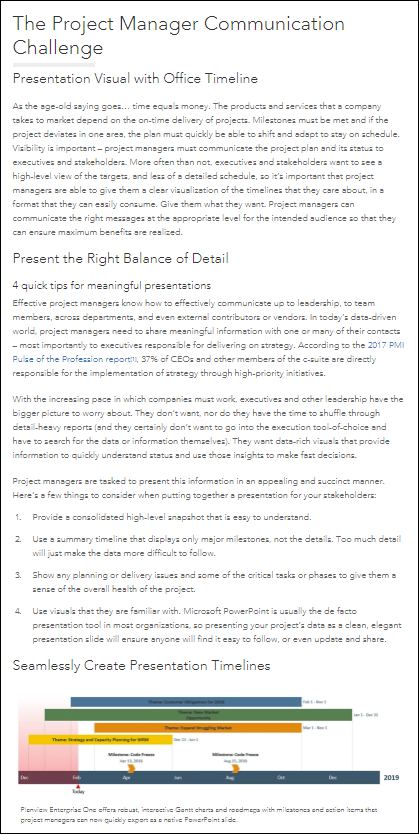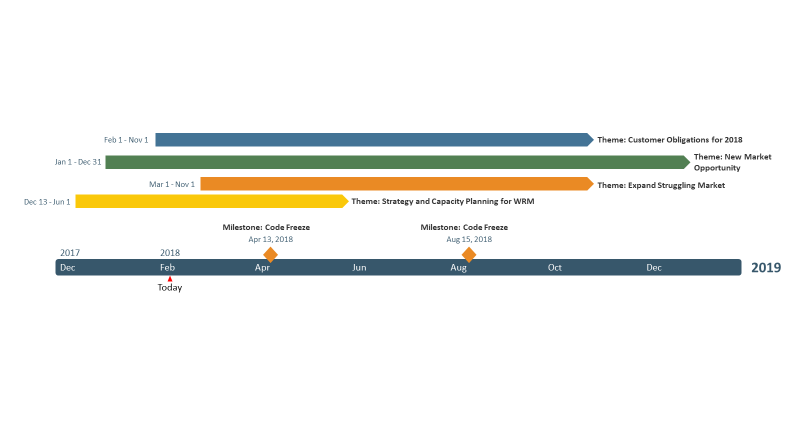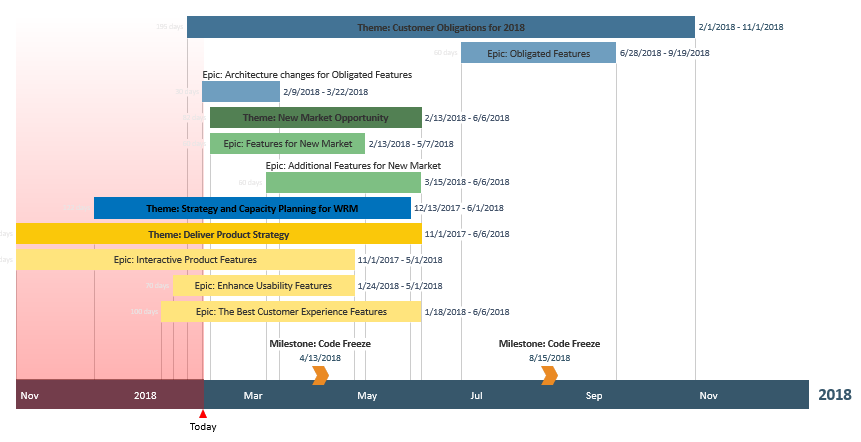
Product managers have an increasingly difficult job. They not only need to listen and understand customers, operations, markets, sales, and engineering, but they then must make difficult decisions that require communicating and guiding the organization to embrace trade-offs made across conflicting priorities. Product managers carry this responsibility from idea to delivery, bringing cross-functional teams together and aligning diverse functions.
The most effective product managers do this while constantly learning, taking in feedback, and adjusting their message appropriately. This requires them to be great communicators and to be able to share a vision from idea to delivery.
Roadmap from product strategy to delivery
As a product manager, I know firsthand what it is like to share an 18-month roadmap to leadership in the morning and then turn around and share a 12-month roadmap to a customer. If that’s not challenging enough, I then will review the details of the upcoming release with engineering, followed by a flip of the switch—internal to external—to review the features using different language with marketing. All in the same day! So, how do I do this?
It’s a challenge, but it’s made possible by connecting product strategy to delivery:
- Provide a consolidated high-level roadmap, highlighting future value that is easy to understand;
- Quickly export current high-level roadmaps for the upcoming release while overlaying future ideas that may still be just that—ideas;
- Use a summary timeline that displays only major milestones, not the details. Too much detail will just make the data more difficult to follow;
- Use a detailed timeline that displays the current release schedule review and get a sense of the overall health of the project; and
- Quickly modify descriptions to test messaging and obtain feedback
Transform product strategy to delivery … visually
When planning new product ventures, I don’t want to pursue something that isn’t going to deliver on our corporate strategies. I focus on how to continue expanding our products in alignment with the company direction and vision, but still must consider customer experience, retention, and market forces when creating a roadmap. Therefore, I always start with strategy.
I create themes and epics to deliver our product strategy. I plan at a high level, then add in the details from our engineering system as we work through the stories and intricacies of what it will take to deliver it. At any time, I can export a timeline from the view of our strategic themes or the details of a specific release. To do so, I use the de facto communication tool for any organization or business, from product managers all the way to executives and leadership—Microsoft PowerPoint.
I’m constantly sharing and talking about our product roadmap. That is the best way to know that we are making the right decisions for our company and ultimately, our customers.

No more frustration! No more wasted time in PowerPoint!
Since I present roadmaps to a spectrum of leadership, internal cross-functional teams, and customers, I create A LOT of different versions of the same roadmap. And it’s very time consuming. I spend hours creating them, only to spend even more time collecting status reports and updating information on the PowerPoint versions after the work begins in executing the roadmaps.
Thankfully, this stress is no more!
Now, I can create roadmaps from planned and in-flight work in a single system. My product strategy is “connect to execution.” I then export it to PowerPoint and can control what level of detail I export. So, if I’m talking to engineering or a customer, I can include details necessary to have the right conversation at the right level.
Create a roadmap at the right level of detail for the right conversation.
Future product strategy
Since I can export what is already planned and in-flight into a timeline of native PowerPoint objects, I can also easily modify it to create different versions of the future! It’s great. I can overlay future ideas on what we have planned or are doing today. This enables me to create a holistic product strategy roadmap in PowerPoint in a fraction of the time I used to.
Since I’m using Office Timeline’s add-in, I can customize the timelines with templates and other formatting functionalities. I can even create my own custom templates using our corporate colors, enabling leadership to just add it to their board meeting presentations.
Product management can be hard. You have to manage everything from strategy to the details of delivery. That means you have to engage with everyone —both internally and externally of the organization. Anything you can do to reduce the time preparing for conversations and spend more time having the conversations, the better your product will be. Things move fast. You must move faster.
As a Planview user, you get full access to Office Timeline Plus Edition for two weeks. Get the Office Timeline 14-day trial now to build even more impressive PowerPoint presentations effortlessly. Check out the article: The Project Manager Communication Challenge or read more about this topic at the McKinsey and Company article “Product managers for the digital world.“



![Collectively Deliver on Strategy with Digital Transformation [Video]](https://blog.planview.com/wp-content/uploads/2018/07/Collectively-Deliver-on-Strategy-with-Digital-Transformation-2.jpg)

